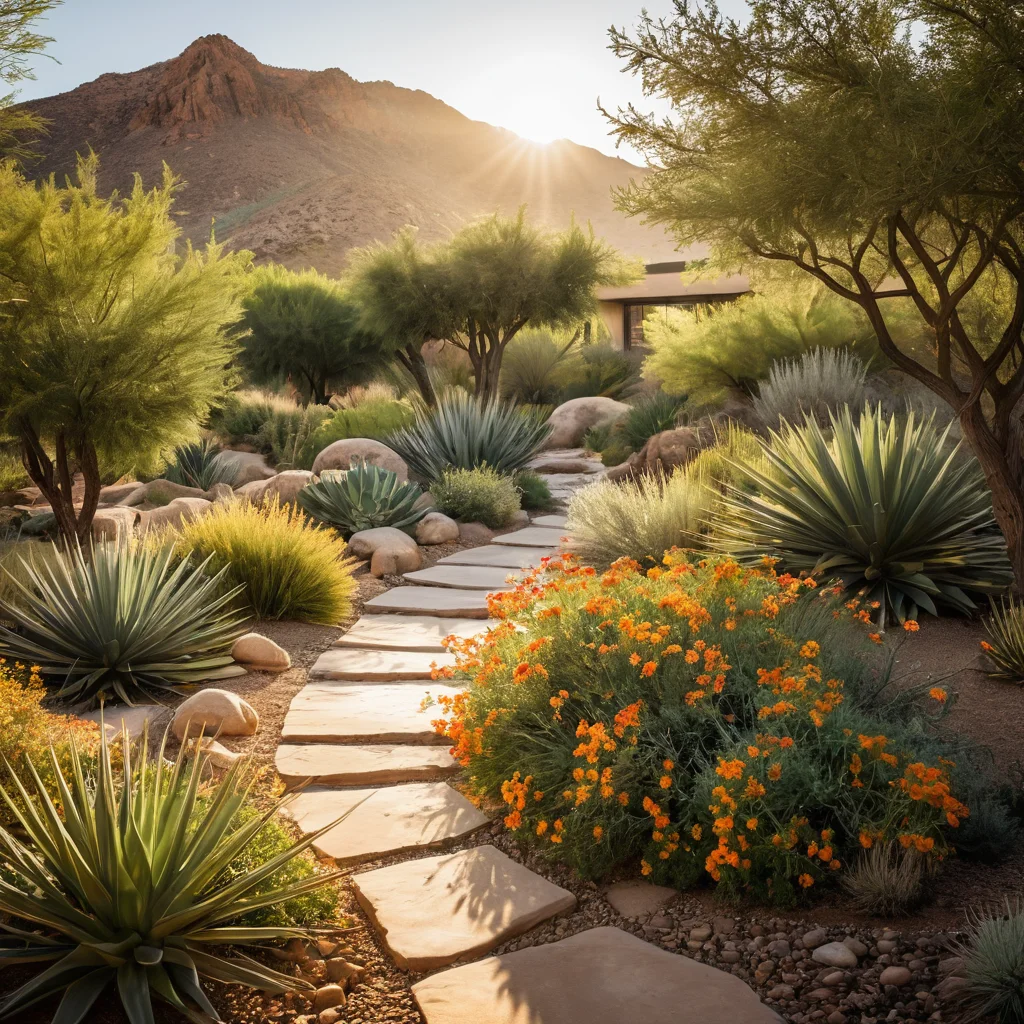Imagine: the midday sun gently warms your skin, the air is filled with the aroma of heated earth and dry grasses, and before you lies a corner where every stone, every stem seems to be part of an ancient story. This is not a distant desert, this is your own garden, which can become just as captivating. Once, I couldn’t even imagine that my small plot of land could be transformed, but one day, inspired by a trip to arid regions, I decided to create a small corner at my dacha reminiscent of the beauty of minimalism and the resilience of nature. And you know, it turned out to be not just easy, but an incredibly transformative activity. Creating a desert garden is not just about aesthetics, but also about a deep understanding of plant hardiness, about finding harmony in simplicity, and about the possibility of having a beautiful garden with minimal care. It’s an invitation to creativity, where every element matters, and the result is a place of strength and tranquility.
What is a Desert Garden and Why Do You Need One at Your Dacha?
So, what is a desert garden? At first glance, it might seem like a contradiction: after all, we are used to lush flowerbeds and green lawns. But a desert garden is a landscape design style that imitates the natural beauty of arid regions: deserts, semi-deserts, steppes, or even mountain plateaus. It is characterized by the use of drought-resistant plants, natural stones, gravel, and sand. It’s not just a collection of succulents in pots, but an entire ecosystem created with an understanding of the principles of minimalism and environmental friendliness.
Why should you consider creating such a corner at your dacha? Firstly, practicality. A desert garden is an ideal solution for those who don’t want to spend a lot of time watering and caring for it. The plants used here are adapted to lack of moisture, which means your garden will be pleasing to the eye even on the hottest summer days when other plants may wilt. It’s a real find for busy people or those who visit their dacha occasionally.
Secondly, aesthetics. Such a garden looks very stylish, modern, and unusual. It brings an element of exoticism and minimalism to the familiar dacha landscape. The absence of lush greenery is compensated by the variety of textures, shapes, and shades of stones, gravel, and plants. This creates a sense of calm, peace, and spaciousness.
Thirdly, environmental friendliness. A desert garden requires significantly less water than a traditional garden, which is especially relevant in the context of a changing climate and rising resource costs. The use of local or well-adapted plants also contributes to biodiversity conservation.
Finally, it’s creative freedom. Creating a desert garden is an opportunity to express your imagination, to play with shapes, colors, and materials. You can create a composition that reminds you of your favorite places or simply reflects your inner state. It’s your personal oasis, created with love and care.
So, if you’re looking for a way to make your plot unique, low-maintenance, and stylish, a desert garden is exactly what you need. It will add a special touch to your garden and bring many pleasant moments.
Key Features of a Desert Garden: How to Create the Atmosphere of Arid Lands
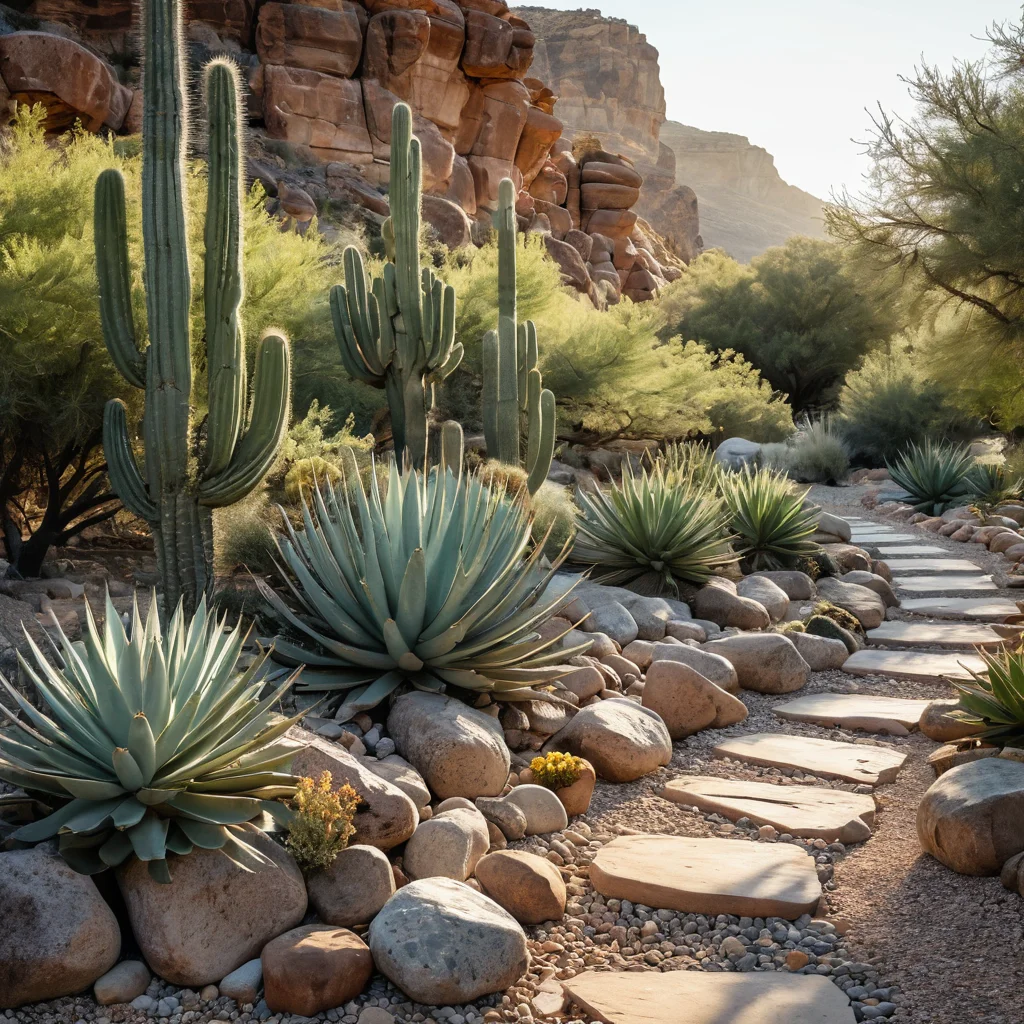
For your garden to truly resemble a corner of arid lands, it’s important to pay attention to several key elements. It’s not just scattered stones and cacti, but a well-thought-out composition that conveys the spirit of the desert or steppe.
1. Minimalism and Simplicity of Forms:
- The main principle is less is more. Avoid cluttering with details.
- Prefer clean lines and simple shapes in design.
- The space between plants or compositions should be noticeable, creating a sense of openness.
2. Color Palette:
- The base is natural, muted tones: sandy, beige, terracotta, gray, ochre.
- Bright accents are acceptable, but they should be dosed – these can be flowering plants or decorative elements.
- The contrast of textures plays an important role: smooth stones, rough gravel, prickly plants.
3. Use of Stones and Gravel:
- Stones are the foundation of a desert garden. They can be of different sizes: from small gravel to large boulders.
- Gravel or small crushed stone is often used as a mulching material, replacing traditional soil or grass. It’s not only beautiful but also effective: gravel drains well, prevents weed growth, and retains soil moisture.
- Large stones are used as accents, creating relief and giving the composition monumentality.
4. Plant Selection:
- The key aspect is drought resistance. Plants should be able to survive with minimal watering and high temperatures.
- Preference is given to plants with silvery or gray foliage that reflects sunlight, or plants with thick, fleshy leaves capable of storing moisture (succulents).
- Prickly plants, such as cacti and yuccas, fit perfectly into the concept.
- Grasses, sedums, stonecrops, euphorbias, echinaceas, and sages are also suitable.
5. Dryness and Ease of Care:
- A desert garden implies minimal watering. The soil here often looks dry, which is natural for this type of garden.
- The almost complete absence of traditional lawns and lush flowerbeds reduces the need for frequent mowing and weeding.
6. Atmosphere and Mood:
- Creating a sense of calm, solitude, and unity with nature.
- This garden is conducive to meditation and relaxation; it’s as if it transports you to a completely different world where time flows differently.
By creating a desert garden, you are not just greening a plot, but forming a special space filled with meaning and harmony. It’s your personal corner of tranquility, where nature appears in all its austere yet majestic beauty.
Plant Selection for a Desert Garden: Low-Maintenance Succulents and Drought-Resistant Flowers
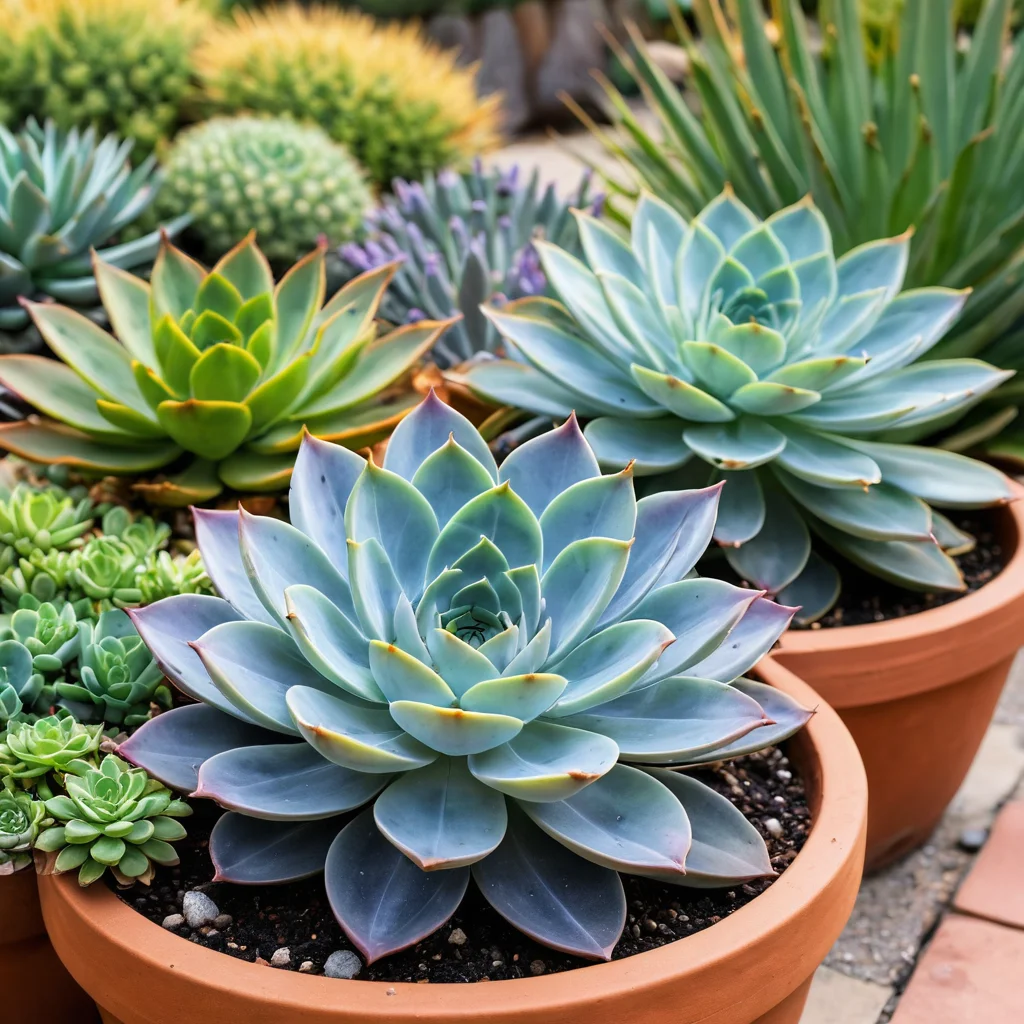
Plants are the soul of any garden, and for a desert corner, they become true stars. The main rule when choosing them is maximum drought resistance and low maintenance. Believe my experience, once you choose the right plants, caring for such a garden will be a real pleasure, not a burden.
1. Succulents – Kings of Drought:
- Sedums (Stonecrops): There is a huge variety of sedums, from low-growing groundcovers to taller species with fleshy leaves and bright inflorescences. They tolerate heat and drought perfectly. Special attention should be paid to varieties like ‘Autumn Joy’, ‘Matrona’, ‘Angelina’.
- Echeverias: These plants with rosettes of leaves resembling flowers look very decorative. They prefer bright sun and infrequent watering.
- Euphorbias: Many euphorbias have a unique shape and texture resembling cacti, but they are more frost-resistant. For example, cypress spurge or large-flowered spurge.
- Agaves and Yuccas: These striking plants with stiff leaves will give the garden a Mediterranean or even Mexican flair. The threadleaf yucca winters well in the middle latitudes.
- Cacti: If your climate allows, you can plant some types of frost-resistant cacti directly in the open ground.
2. Drought-Resistant Perennials:
- Lavender: Its fragrant blue inflorescences and silvery foliage fit perfectly into the concept. Lavender loves sun and well-drained soil, and absolutely does not tolerate waterlogging.
- Sage: Ornamental sages (e.g., woodland sage) have beautiful inflorescences and tolerate drought well.
- Echinacea: These bright flowers are not only beautiful but also very hardy. They love sun and do not require frequent watering.
- Carnations: Some types of carnations, especially those that grow in meadows, are highly drought-resistant.
- Yarrow: Ornamental yarrow varieties with flat inflorescences are an excellent choice for creating textured compositions.
- Veronica: Perennial veronicas with their slender inflorescences will add vertical accents.
3. Ornamental Grasses:
- Blue Fescue: Its silvery-blue fluffy clumps create striking cushions.
- Feather Grass: The delicate, wind-swept feathers of feather grass give the garden lightness and airiness.
- Millet: Ornamental millet varieties with different foliage colors and striking panicles.
4. Annuals for Accents:
- If you want to add bright colors for one season, you can use drought-resistant annuals. For example, portulaca with its bright, rose-like flowers, or calendula.
Selection Tips:
- Study the local climate: Choose plants that thrive in your region.
- Pay attention to conditions: Most plants for a desert garden love full sun and well-drained soil.
- Create groups: Plant similar plants in groups so they look better and are comfortable together.
- Don’t be afraid to experiment: A desert garden is a place for creativity. Try different combinations, find your favorite plants.
Remember that the beauty of a desert garden lies in its simplicity and hardiness. Properly selected plants will become your loyal allies in creating this unique corner.
Suitable Stones and Materials: From Gravel to Boulders for Your Desert Corner
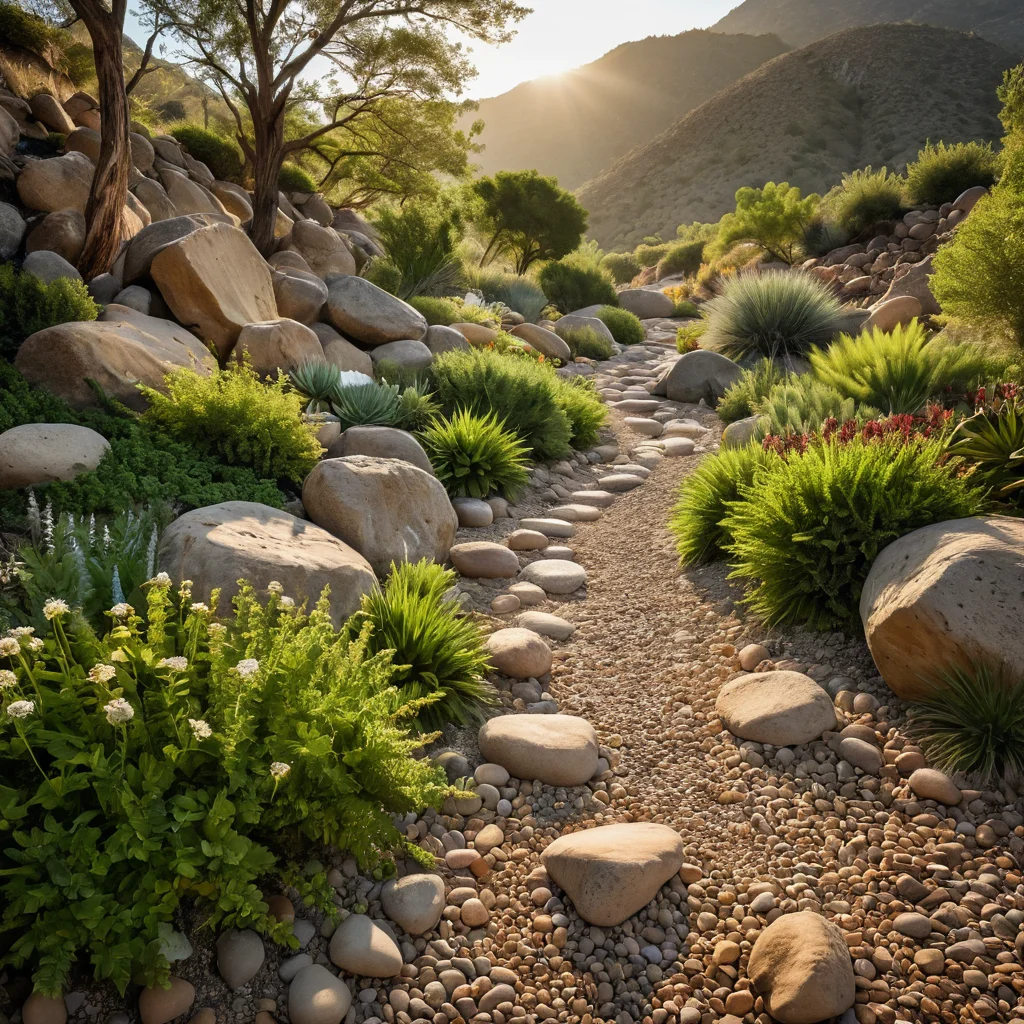
Stones and gravel are not just fillers for a desert garden; they are its architecture, its backbone. They are what create that very atmosphere of dryness, monumentality, and natural harmony. I always say that choosing the right materials is half the battle!
1. Gravel and Crushed Stone – The Foundation:
- Gravel: This is perhaps the most versatile material. It can be of different fractions (sizes) and colors: from fine sandy to coarse, gray, beige, brown, or even reddish. Gravel is ideal for covering large areas, creating paths, and filling gaps between plants. It drains well, helps control weeds, and retains soil moisture.
- Decorative crushed stone: Looks great as a top mulch layer. Its sharp edges play beautifully in the sun. Marble chips (white, pink, gray) are particularly popular, but for a desert garden, it’s better to choose more natural shades.
- Quartz sand: Can be used to create fine textured elements or for mixing with other materials.
2. Large Stones and Boulders – Accents and Character:
- Boulders: These are the “sculptures” of your garden. Large, water-worn, or interestingly shaped, they can become central elements of the composition. Place them in groups or individually, but in a way that looks natural.
- Cobblestones: Medium-sized stones that can be used to create borders, small retaining walls, or simply as decorative elements that emphasize the beauty of plants.
- Flat stones (flagstone): Ideal for creating small paved areas, steps, or simply as a base for a vase with a plant.
3. Color and Texture of Stones:
- Naturalness: Try to choose stones that look natural, as if they have been lying on the ground for centuries.
- Combination: Don’t be afraid to combine stones of different textures and sizes, but try to stick to one color scheme or use contrasting but harmonious combinations. For example, gray boulders with beige gravel.
- Patina: Stones covered with moss or lichen will give the garden a vintage and lived-in look.
4. Other Materials:
- Ceramic shards and old pottery: If you love the “shabby chic” style or want to add a touch of antiquity, you can use broken ceramics or old clay pots.
- Wood (dry): Snags, wood slices, or old logs can become interesting decorative elements, but they should be used sparingly so as not to disrupt the overall concept.
Where to Get Materials:
- Hardware stores and nurseries: Here you can find a wide range of gravel, crushed stone, and decorative stones.
- Natural quarries: If possible, you can purchase stones directly from mining companies; it’s often more cost-effective.
- Local water bodies: Sometimes, beautiful water-worn stones can be found on the banks of rivers or lakes, but they must be thoroughly washed before use.
- DIY: If you have old stones or shards, give them new life in your garden.
When selecting stones and materials, always remember the main thing – they should create a sense of naturalness, emphasize the beauty of the plants, and form an atmosphere of peace. Don’t be afraid to experiment, because it is in the combination of different textures and shapes that the unique look of your desert garden is born.
Step-by-Step Guide: How to Create a Desert Garden on Your Plot with Your Own Hands
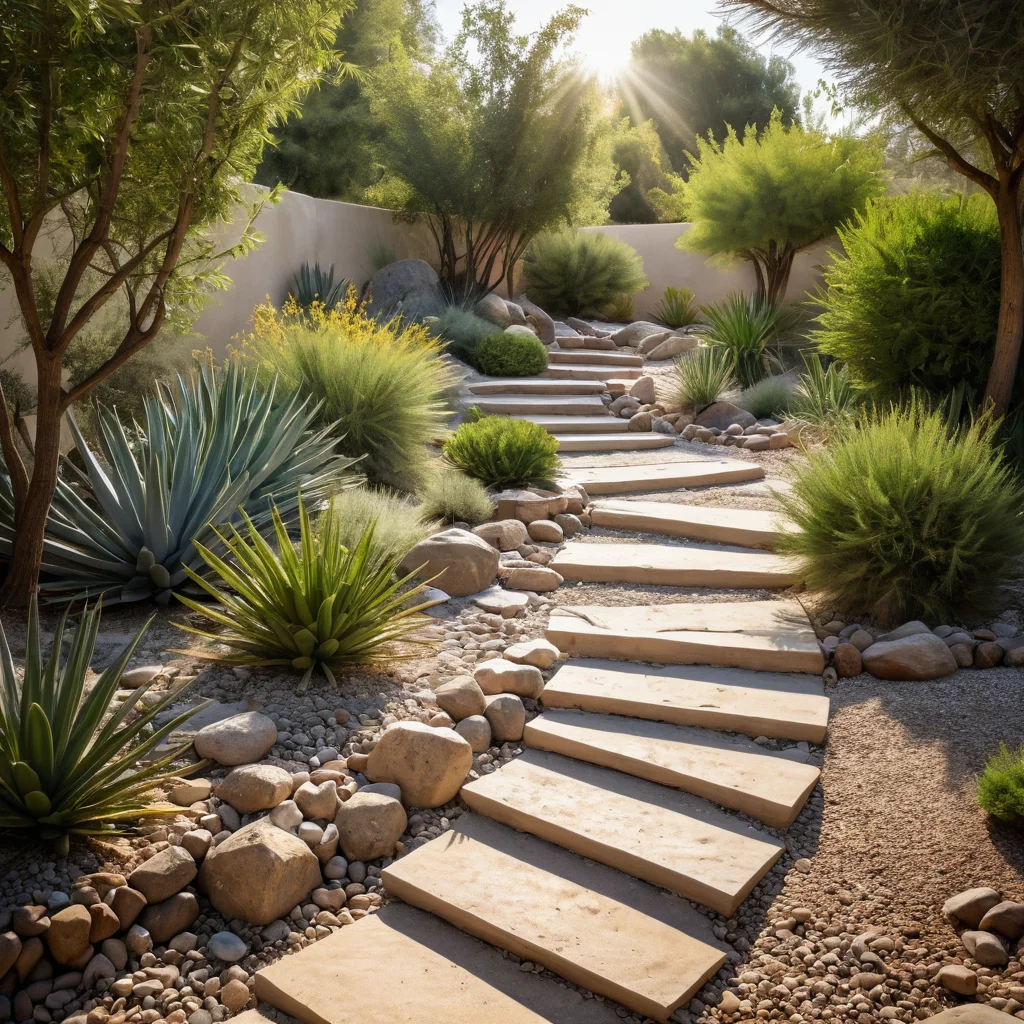
Creating a desert garden with your own hands is an exciting process that is within everyone’s reach. The main thing is to act consistently and with attention to detail. Let me guide you through all the stages, sharing my experience.
Step 1: Planning and Site Selection
- Decide on size and shape: A desert garden can be a small cozy corner or occupy a significant part of the plot. Start small if you are a beginner.
- Choose a sunny spot: Most plants for such a garden love bright light. A south or southwest slope is ideal, or simply an open, well-lit area.
- Consider the terrain: Small elevations or slopes will only add interest to your composition. You can create artificial mounds of soil and gravel.
- Sketch it out: You don’t have to be an artist. Just draw the approximate placement of large stones, plants, and gravel areas. This will help you visualize the future garden.
Step 2: Site Preparation
- Clear the area: Completely remove weeds, grass, and large stones (if they don’t fit your concept). The roots of perennial weeds should be dug out as thoroughly as possible.
- Marking: Use stakes and string to mark the boundaries of the future composition according to your sketch.
- Creating relief (if necessary): If you plan a hilly structure, now is the time to add soil, forming the desired elevations.
Step 3: Drainage Setup
- This is a critical step! Desert plants cannot tolerate waterlogging.
- Laying the drainage layer: At the bottom of the future composition, lay a layer of coarse gravel or broken brick, 10-15 cm thick.
- Installing geotextile (optional): To prevent gravel from mixing with the soil, you can lay a layer of geotextile over the drainage, making holes for the plants.
Step 4: Filling with Gravel and Placing Stones
- Filling with gravel: On top of the drainage layer (or geotextile), pour decorative gravel or crushed stone of the desired fraction. The layer should be thick enough (5-10 cm) to completely cover the soil and prevent weed growth.
- Placing large stones: Carefully position boulders and large stones according to your plan. Part of the stone should be embedded in the gravel or soil so that they look natural, as if they grew from the ground.
Step 5: Planting Plants
- Preparing planting holes: Make holes in the gravel layer where plants are to be planted. If the soil beneath the gravel is dense, loosen it.
- Planting: Carefully remove plants from their pots, trying not to damage the roots. Plant them in the prepared holes, cover with soil, and lightly compact.
- Mulching around plants: You can further mulch the root zones with fine gravel or sand.
Step 6: Final Touches
- Adding small stones and pebbles: Arrange small stones, pebbles, and perhaps decorative elements (dry snags, ceramics) to complete the composition.
- Initial watering: After planting, water the plants thoroughly so they settle into the new soil.
What You’ll Need:
- Shovel, rake
- Wheelbarrow (for moving soil, gravel, stones)
- Geotextile (optional)
- Coarse gravel or broken brick (for drainage)
- Decorative gravel or crushed stone (main covering material)
- Large stones, boulders
- Selected plants
- Gloves (for handling prickly plants)
Creating a desert garden is like painting a picture where stones, gravel, and plants are your colors. Don’t be afraid to experiment, and your garden will surely become a unique work of art!
Drainage Setup and Soil Preparation: The Key to the Longevity of Your Desert Garden

If you want your desert garden to delight you for many years to come, and the plants in it to feel excellent, then you need to approach drainage and soil preparation with all seriousness. I always insist that this is the foundation, especially for those plants that cannot tolerate waterlogging.
1. The Importance of Drainage:
- Reason: Most plants suitable for a desert garden (succulents, many grasses and sedges) originate from regions with very dry climates and well-drained soil. Their root systems easily rot with excess moisture.
- Consequences of poor drainage: Root rot, plant diseases, stunted growth, and ultimately, death.
- Goal: To ensure rapid removal of excess water from plant roots.
2. How to Set Up Drainage:
- Site selection: If the plot has poor drainage from the start (e.g., clay soil), creating a drainage system becomes mandatory.
- Creating a raised bed: One of the most effective ways is to create a raised bed or mound. This can be done by simply adding a layer of soil and gravel on top of the existing level.
- Laying the drainage layer:
- At the bottom of the prepared area (if creating at ground level) or at the bottom of the raised bed, lay a layer of drainage material.
- Materials: This can be coarse gravel (fraction 20-40 mm), expanded clay, broken brick, or large pebbles. The layer thickness should be at least 10-15 cm.
- Distribution: Distribute the drainage material evenly over the entire area.
- Geotextile: To prevent fine soil or gravel particles from clogging the drainage layer, you can lay a layer of geotextile on top. It allows water to pass through but retains particles. Cut holes in the geotextile where plants are to be planted.
3. Preparing the Soil Mix:
- Ideal soil: Desert plants need light, loose, well-drained soil with low organic content.
- Mix composition:
- Garden soil: A small portion (about 30%).
- Coarse sand: An essential component (30-40%). It improves structure and drainage.
- Fine gravel or perlite: Further improves air permeability (20-30%).
- Compost or humus: Add very carefully and in minimal quantities (no more than 10%), as excess organic matter is harmful to most succulent plants.
- Preparation: All components are thoroughly mixed.
- Filling: The resulting soil mix is laid on top of the drainage layer (or geotextile), forming the necessary relief.
4. Finishing with Gravel:
- Layer: On top of the prepared soil, pour a layer of decorative gravel or crushed stone, 5-7 cm thick. This layer is not only decorative but also serves as additional mulch, suppressing weed growth and retaining soil moisture.
- Gravel selection: Prefer natural shades (beige, gray, brown) that harmonize with the plants and stones.
Tips from an Experienced Gardener:
- Checking drainage: After rain, observe how quickly the water drains. If puddles remain for several hours, the drainage may need adjustment.
- Don’t overdo fertilizers: Desert plants thrive in poor soils. Excess nutrients can lead to weakness and diseases.
- Adaptation to your plot: Even if you’ve created perfect drainage, observe the plants. They may need a little more attention in the first few years as they adapt to new conditions.
Remember that proper soil preparation and good drainage are an investment in the health and beauty of your desert garden. This is the guarantee that your plants will feel comfortable and be able to fully realize their potential.
Desert Garden Care: Watering, Fertilizing, and Seasonal Tasks
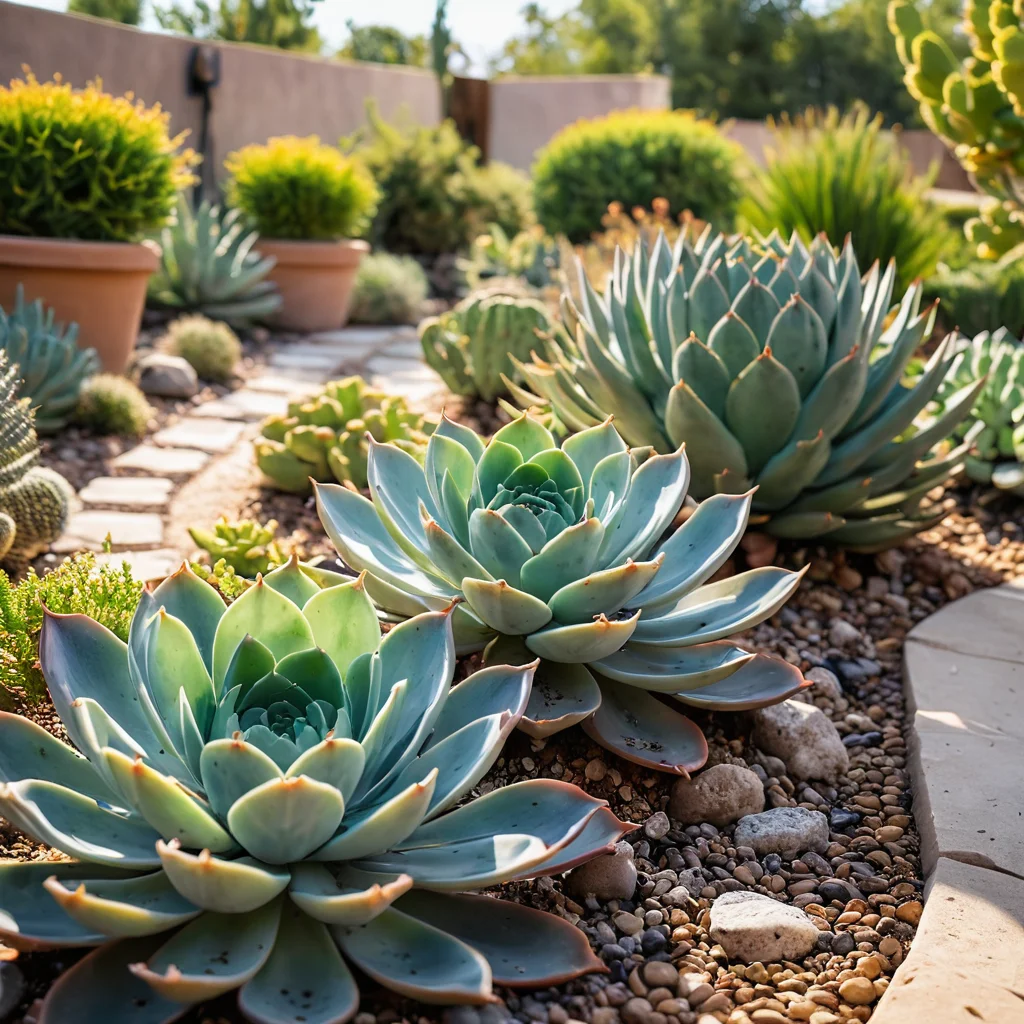
One of the main advantages of a desert garden is its relative low maintenance. However, like any living thing, it requires minimal but regular care. Believe me, this care brings special pleasure, as it is aimed at maintaining that wild, natural beauty.
1. Watering:
- The main rule: better under-water than over-water. Most plants in such a garden are adapted to arid conditions.
- Frequency: During the active growth period (spring-summer), watering may be needed once every 1-2 weeks, and in hot, dry weather – possibly once a week. In autumn and winter, watering is reduced to a minimum or completely stopped, especially if winters are mild.
- Watering method: Water plants at the base, trying not to get water on the leaves, especially in sunny weather (to avoid burns). Use a watering can or a drip irrigation system if available.
- Checking moisture: Before watering, make sure the top layer of gravel and the soil underneath are truly dry. You can simply touch the soil with your finger a few centimeters deep.
- Seasonal features: Watering is more intensive in summer, moderate in spring and autumn, and minimal in winter.
2. Fertilizing:
- Moderation is the key to success. Desert plants generally do not need abundant fertilization. Excess nutrients can lead to excessive growth, loss of decorative qualities, and reduced resistance to diseases.
- When and with what:
- Spring: You can apply a complex mineral fertilizer with low nitrogen (N) and increased phosphorus (P) and potassium (K). This promotes flowering and strengthens the root system.
- During the season: Generally, no additional fertilizing is required. If you notice that a plant looks weakened, you can give it a light feeding with a universal fertilizer for succulents or cacti, diluted to half the recommended dose.
- Do not fertilize: Dry, recently planted plants, as well as plants that clearly do not need nutrients.
3. Seasonal Tasks:
- Spring:
- Cleaning: Remove winter cover (if any), clear away dry leaves, branches, and debris accumulated over winter.
- Weeding: Remove any emerging weeds.
- Adding gravel: If necessary, refresh the gravel layer, especially where it may have washed away or settled.
- Pruning: Remove any frozen or damaged parts of the plants.
- Summer:
- Watering: Regular but moderate, according to plant needs and weather conditions.
- Removing spent flower stalks: For some plants, this stimulates re-blooming or simply improves their appearance.
- Pest control: Periodically inspect plants for pests or diseases.
- Autumn:
- Reduce watering: Gradually decrease watering frequency.
- Winter preparation: Some heat-loving plants (e.g., certain types of agaves or cacti) may require winter protection.
- Cleanup: Remove fallen leaves so they don’t interfere with plant growth in spring.
- Winter:
- Minimal care: The main task is protection from excess moisture and frost (if protection is needed).
- Observation: Monitor the condition of shelters and plants.
What Else to Remember:
- Observational skills: The best care is attentive observation of plants. They will tell you what they need.
- Adaptation: Over time, you will get to know your plants’ needs better and be able to adjust care accordingly.
- Patience: A desert garden doesn’t require daily fuss. It’s meant to bring peace and harmony.
Caring for a desert garden is not a burden, but an opportunity to get to know nature better, learn to appreciate resilience, and find beauty in simplicity. By following these simple rules, you can enjoy your unique corner for many years.
Common Mistakes When Creating a Desert Garden and How to Avoid Them
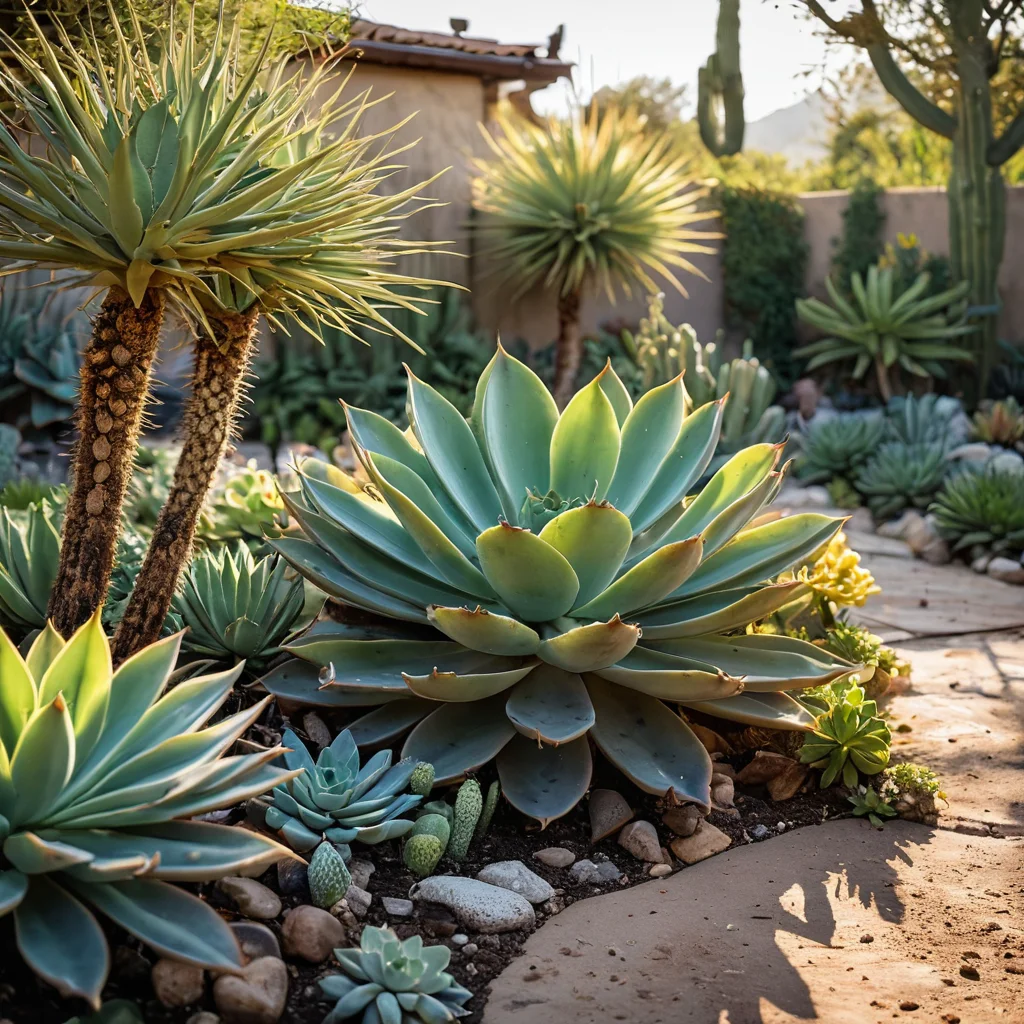
Even with the best intentions, mistakes can be made during the garden creation process. Don’t worry, it’s part of learning! I’ve been through it myself, and now I want to share the most common pitfalls with you so that your desert garden turns out perfect from the first try.
Mistake 1: Incorrect Site Selection
- Problem: Planting sun-loving plants in shade, or conversely, creating a garden on a site that is constantly flooded by rain without proper drainage.
- Consequences: Plants become leggy, lose their decorative appeal, get sick, and roots rot.
- How to avoid: Carefully study the needs of the chosen plants. Before starting work, observe the site throughout the day – where there is the most sun, where water accumulates.
Mistake 2: Neglecting Drainage
- Problem: Absence or insufficient thickness of the drainage layer, use of fine gravel that quickly silts up.
- Consequences: Waterlogging at the roots, which is fatal for most desert plants.
- How to avoid: Always create a reliable drainage layer of coarse gravel or expanded clay (at least 10-15 cm). Use geotextile to separate layers.
Mistake 3: Overwatering
- Problem: Watering out of habit, as for a regular garden, causing the soil to remain constantly moist.
- Consequences: Root rot, fungal diseases.
- How to avoid: Water only when the soil has completely dried out. It’s better to water less often but more abundantly (for deep moisture penetration), but even this will be too much for most succulents. Rely on the appearance of the plants and the condition of the soil.
Mistake 4: Excess Organic Matter and Fertilizers
- Problem: Adding large amounts of compost, humus, or frequent application of fertilizers.
- Consequences: Plants become weak, soft, lose their resistance to drought and diseases, and stop flowering.
- How to avoid: Desert plants prefer poor, mineral soil. Use light, loose mixes with sand and gravel. Fertilize very moderately, only in spring, and use fertilizers with low nitrogen content.
Mistake 5: Overcrowded Composition
- Problem: Too many different plants, stones, and decorative elements in a small area.
- Consequences: Lack of a sense of space, “visual noise,” plants are cramped.
- How to avoid: Adhere to the principle of minimalism. Leave enough free space between plants. Use a limited number of plant species and materials.
Mistake 6: Incorrect Plant Selection
- Problem: Planting heat-loving or moisture-loving species that are not suitable for your climate or soil conditions.
- Consequences: Plants overwinter poorly, get sick, and do not develop.
- How to avoid: Carefully study the characteristics of plants before purchasing. Choose frost-resistant and drought-resistant varieties adapted to your climatic conditions.
Mistake 7: Using Unsuitable Gravel
- Problem: Using dusty gravel, too fine or, conversely, too coarse a fraction, not suitable for the overall style.
- Consequences: Unattractive appearance, silting, drainage problems.
- How to avoid: Choose high-quality, clean gravel or crushed stone. Ensure the fraction and color harmonize with your plants and stones.
Tips for Preventing Mistakes:
- Plan: Don’t start work until you have a clear plan and an understanding of what you want to achieve.
- Research: Read books, articles, look at examples of desert gardens.
- Start small: If you’re unsure, create a small corner to practice the technique and understand your preferences.
- Don’t be afraid to change: If something didn’t work out, don’t be afraid to redo it. Gardening is a process, not a final result.
By avoiding these common mistakes, you can create a truly beautiful, long-lasting, and low-maintenance desert garden that will be a source of your pride and a favorite relaxation spot at your dacha.
